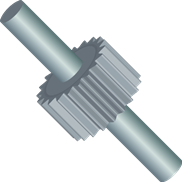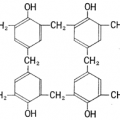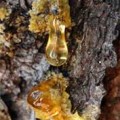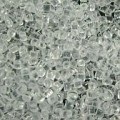
Super engineering plastics (hereinafter abbreviated SEP) is a reinforced resin of engineering plastic function.
In part it is also referred to as a “Special engineering plastics.”
SEP is a highly heat-resistant third generation synthetic resin with improved intrinsic properties of the plastic being susceptible to heat.
By high heat resistance, the resistance to friction and heat increase in the moving part, overall mechanical strength also has been improved.
General nature, DTUL is at 150 ℃ or more, tensile strength 500kgf / cm2 or more, flexural modulus 25000kg / cm2 or more.
Comparison with metal parts
<< Advantages >>
The material itself can be the weight of the product
The accurately molded complex shapes can be produced inexpensively
It has a sufficient strength, and to enable the size of the apparatus to get to make a complex shape of the interior and exterior to facilitate
The possible cost reducing the number of components it is possible to integrate the components
Not rust
Even if there is no oil have excellent wear resistance
Also a good fixing at the time or was unnecessary painting paint
Available in the 3D printer
<< Cons >>
The strength of the parts is reduced under high temperature
It and to decrease the strength of the parts under low temperature,
The poor wear resistance because the hardness is lower than that of the metal
The degraded by ultraviolet radiation in an environment exposed to sunlight
Which may be brittle even when exposed to solvents, chemicals, gas
Many those having a molecular structure encapsulating many benzene ring which does not exist in nature, and poor biodegradability
◇ Non-crystalline SEP
1. Polysulfone (PSF)
Amber transparent resin. Toughness, heat resistance, excellent hydrolysis resistance, acid at high temperatures, alkaline hot water to it but stable, must be careful in an organic solvent. Creep resistance, low-temperature properties, electrical properties, flame retardancy, and is excellent in dimensional stability. It does not decrease the physical properties by moisture absorption, but because it will cause air bubbles or silver, must have sufficient drying prior to molding.
2. Polyether sulfone (PES)
Amber transparent resin. Heat resistance, hydrolysis resistance, and is excellent in flame retardancy, resistance to creep. Dimensional stability is also good. Chemical resistance is excellent to good stress crack resistance, care must be taken in an organic solvent.
3. Polyarylate (PAR)
Transparent resin. Currently, there are many alloy composite system. PAR / PC, PAR / PET, PAR / PA, is alloy such as PAR / fluorine resin are commercially available. Heat resistance (Tg: 195), is characterized ultraviolet barrier property, impact resistance, surface hardness, creep resistance, recovery bending elasticity. Because it has an ester bond in the molecule, it is necessary to be careful in hot water or steam. Also you need to be careful in an organic solvent.
4. Polyamide-imide (PAI)
Heat resistance (continuous use temperature of 250), impact resistance, fatigue resistance, flame resistance, abrasion wear resistance, chemical resistance, it is excellent in stress crack resistance. Electrical properties also good.
5. Polyetherimide (PEI)
Amber transparent resin. Heat resistance, mechanical properties, flame retardancy, and excellent electrical properties. Care must be taken in an organic solvent.
◇ Crystalline SEP
1. Polyphenylene sulfide (PPS)
Very high heat resistance (deflection temperature under load 260 or more). Mechanical strength, stiffness, flame retardance, electrical properties, dimensional stability, I excellent creep resistance. Chemical resistance is particularly excellent, other heat concentrated nitric acid is most acids, not attacked alkali, an organic solvent. It also is excellent in hot water resistance. Since the easy-to appear the characteristics of the filler, sliding property, adhesiveness, conductivity, super-precision moldability, high thermal conductivity, the compound performance imparted with such sealing properties have been developed a number. Since it is excellent particularly cost performance in the super engineering plastics, steady usage has increased. Toughness is low, burrs are likely to occur, there is a problem that the corrosion and wear of the mold to contain sulfur in the molecular structure is large, recently improved grades have been developed.
2. Polyether ether ketone (PEEK)
In the thermoplastic resin, the highest level of heat resistance (continuous use temperature of 240, deflection temperature under load 300 / GF30%). Flame-retardant, low impurity, heat water, radiation resistance, chemical resistance, fatigue resistance is also very good. Molding temperature needs to be increased.
3. Liquid crystal polymer / Liquid crystal polyester (LCP)
Resin showing liquid crystallinity at the time of melting. Liquidity is very good. Rigidity, strength, moldability and water absorption are excellent in low dimensional stability. Burrs and sink marks is relatively small. It is classified into type 1, 2 and 3 by the heat level. Currently type 2’re most used in the market, deflection temperature under load those from 220 to 280. Also, we divided the total aromatic and semi-aromatic system by the molecular structure. All aromatic high heat resistance, semi-aromatic system is characterized by excellent thin-wall flowability. That is anisotropic, the poor adhesion that weld strength is low problems. In addition, because it has an ester bond in the molecule, it is necessary to be careful in hot water or steam. In general and that there is a property of easily adhering to the metal at high temperatures, since a stable purging agent is not commercially available but more than 300, care must be taken to purge methods.
4. Fluorine resin
General term for a resin containing fluorine in the molecule (PTFE, PFA, FEP, E / TFE, PVDF, etc.). Heat resistance, cold resistance, chemical resistance, hot water resistance and weather resistance are excellent. Non-stick, low friction, and excellent high-frequency characteristics.
5. Polyether nitrile (PEN)
In the thermoplastic resin, the highest level of heat resistance (continuous use temperature of 230, deflection temperature under load 330 / GF30%). About twice the general-purpose engineering plastics strength, flame-retardant, low impurity resistance, hot water resistance, chemical resistance, fatigue resistance, creep resistance, sliding property is also very good. Molding can be utilized conventional engineering plastics corresponding injection molding machine. Expensive.
6. Polyimide (PI)
Organic polymer, the highest level of heat resistance (continuous use temperature of 250 or more). Flame retardancy, mechanical strength, abrasion resistance, creep resistance, radiation resistance, it is excellent in dimensional stability.
Thermal properties of SEP (typical)
DTUL: Deflection temperature under load
Tg: Glass transition point
Tm: Melting point
PEN has also been used as an abbreviation of polyethylene naphthalate.
 HEAT-TECH Best Technology Online Shop
HEAT-TECH Best Technology Online Shop 











